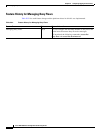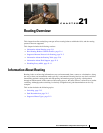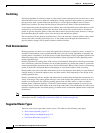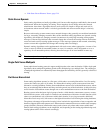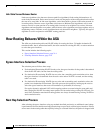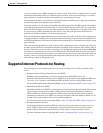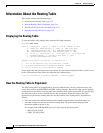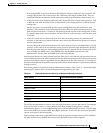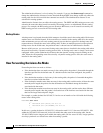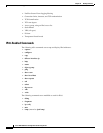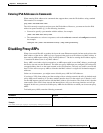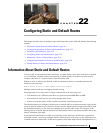
21-6
Cisco ASA 5500 Series Configuration Guide using the CLI
Chapter 21 Routing Overview
Information About the Routing Table
Information About the Routing Table
This section includes the following topics:
• Displaying the Routing Table, page 21-6
• How the Routing Table Is Populated, page 21-6
• How Forwarding Decisions Are Made, page 21-8
• Dynamic Routing and Failover, page 21-9
Displaying the Routing Table
To view the entries in the routing table, enter the following command:
hostname# show route
Codes: C - connected, S - static, I - IGRP, R - RIP, M - mobile, B - BGP
D - EIGRP, EX - EIGRP external, O - OSPF, IA - OSPF inter area
N1 - OSPF NSSA external type 1, N2 - OSPF NSSA external type 2
E1 - OSPF external type 1, E2 - OSPF external type 2, E - EGP
i - IS-IS, L1 - IS-IS level-1, L2 - IS-IS level-2, ia - IS-IS inter area
* - candidate default, U - per-user static route, o - ODR
P - periodic downloaded static route
Gateway of last resort is 10.86.194.1 to network 0.0.0.0
S 10.1.1.0 255.255.255.0 [3/0] via 10.86.194.1, outside
C 10.86.194.0 255.255.254.0 is directly connected, outside
S* 0.0.0.0 0.0.0.0 [1/0] via 10.86.194.1, outside
On the ASA 5505, the following route is also shown. It is the internal loopback interface, which is used
by the VPN hardware client feature for individual user authentication.
C 127.1.0.0 255.255.0.0 is directly connected, _internal_loopback
How the Routing Table Is Populated
The ASA routing table can be populated by statically defined routes, directly connected routes, and
routes discovered by the RIP, EIGRP, and OSPF routing protocols. Because the ASA can run multiple
routing protocols in addition to having static and connected routes in the routing table, it is possible that
the same route is discovered or entered in more than one manner. When two routes to the same
destination are put into the routing table, the one that remains in the routing table is determined as
follows:
• If the two routes have different network prefix lengths (network masks), then both routes are
considered unique and are entered into the routing table. The packet forwarding logic then
determines which of the two to use.
For example, if the RIP and OSPF processes discovered the following routes:
–
RIP: 192.168.32.0/24
–
OSPF: 192.168.32.0/19



